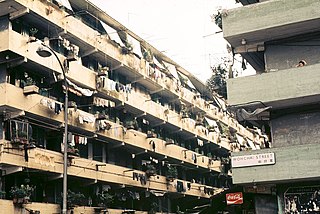
Sham Shui Po is an area of Kowloon, Hong Kong, situated in the northwestern part of the Kowloon Peninsula, north of Tai Kok Tsui, east of Cheung Sha Wan and south of Shek Kip Mei (石硤尾). It is located in and is the namesake of the Sham Shui Po District.

Shek Kip Mei, originally known as Shek Kap Mei, is an area in New Kowloon, to the northeast of the Kowloon Peninsula of Hong Kong. It borders Sham Shui Po and Kowloon Tong.

Public housing in Hong Kong is a set of mass housing programmes through which the Government of Hong Kong provides affordable housing for lower-income residents. It is a major component of housing in Hong Kong, with nearly half of the population now residing in some form of public housing. The public housing policy dates to 1954, after a fire in Shek Kip Mei destroyed thousands of shanty homes and prompted the government to begin constructing homes for the poor.

Sham Shui Po District is one of 18 districts of Hong Kong. It is the second poorest district in Hong Kong, with a predominantly working-class population of 405,869 in 2016 and the lowest median household income of all districts. Sham Shui Po has long been home to poorer new immigrants from mainland China. It also saw the birth of public housing in Hong Kong, as the government sought to resettle those displaced by a devastating fire in its slums. Sham Shui Po also hosted a Vietnamese refugee camp during the influx of migration in the aftermath of the Vietnam War.

So Uk Estate is an early public housing estate in So Uk, a hillside area of Cheung Sha Wan, Kowloon, Hong Kong. The estate has undergone redevelopment, and new housing blocks are being built in place of the ones demolished.

Mei Ho House, formerly part of Shek Kip Mei Estate, Hong Kong, is the last remaining example of a "Mark I" building in a single-block configuration. While the other buildings of the estate dating from the 1950s have been demolished, being replaced by new ones, Mei Ho House was chosen to be preserved and was reopened in 2013 as a youth hostel and heritage museum.

Tai Hang Sai Estate is a private housing estate in Shek Kip Mei, Kowloon, Hong Kong. It is located between Shek Kip Mei Estate and Tai Hang Tung Estate, near MTR Shek Kip Mei station. It consists of 8 residential buildings which were built in 1965 and 1977 respectively. Although it is rental housing, it was developed by a privately owned company, unlike other public housing estates which are built and managed by either Hong Kong Housing Authority or Hong Kong Housing Society.

Nam Shan Estate is a public housing estate in Shek Kip Mei, Hong Kong, located near Tai Hang Tung Estate, Tai Hang Sai Estate, Yau Yat Tsuen and City University of Hong Kong. The estate is located at Shek Kip Mei and was formerly called "Kowloon Tsai". It comprises 8 residential blocks built in 1977. The apartments are self-contained units with private kitchen and toilet facilities.

Tai Hang Tung Estate is a public housing estate in Kowloon Tong, Sham Shui Po District, Kowloon, Hong Kong, located near the Tai Hang Sai and Nam Shan Estates as well as Shek Kip Mei station.

Pak Tin Estate is a public housing estate in Shek Kip Mei, Sham Shui Po, Kowloon, Hong Kong, located between Shek Kip Mei Estate and Chak On Estate.

The following is an overview of Public housing estates in Kwai Chung, Hong Kong, including Home Ownership Scheme (HOS), Private Sector Participation Scheme (PSPS), Sandwich Class Housing Scheme (SCHS), Flat-for-Sale Scheme (FFSS), and Tenants Purchase Scheme (TPS) estates.
Public housing estates in Shek Kip Mei are public housing in an area originally known as Kap Shek Mi in New Kowloon on the North Eastern Kowloon Peninsula of Hong Kong.
The following is a list of public housing estates in Sheung Shui Town, Hong Kong, including Home Ownership Scheme (HOS), Private Sector Participation Scheme (PSPS), Sandwich Class Housing Scheme (SCHS), Flat-for-Sale Scheme (FFSS), and Tenants Purchase Scheme (TPS) estates.
The following shows the public housing estates in Pok Fu Lam, Aberdeen, Wong Chuk Hang and Ap Lei Chau of Southern District, Hong Kong.

The following is an overview of public housing estates in Sham Shui Po, Hong Kong, including Home Ownership Scheme (HOS), Private Sector Participation Scheme (PSPS), and Tenants Purchase Scheme (TPS) estates.

The North Kowloon Magistracy is a historic building and former Magistrate's Court located at No. 292, Tai Po Road, Shek Kip Mei, Kowloon, Hong Kong.
Public housing estates in Hong Kong are the most common kind of public housing in Hong Kong. Typically, estate units are leased to low-income people. There are three organizations that provide housing units. They are Hong Kong Housing Authority (HKHA), Hong Kong Housing Society (HKHS), and Hong Kong Settlers Housing Corporation Limited.

Resettlement Areas, or Resettlement Estates are an early form of public housing in Hong Kong. They were built between 1954 and 1975. The designs used are Mark I to Mark VII. Most are found in the new towns of Hong Kong. It was managed by the Resettlement Department. In 1973, it was organized into Hong Kong Housing Authority. Then, resettlement areas began to be referred as 'estates'. It was classified as 'Category B Public Housing Estates'. Newer housing projects are called 'Category A Public Housing Estates'. Today, only Mei Ho House remains standing as a Mark I block.
Mark Blocks are an early type of public housing that preceded the designs of modern public housing blocks. There are seven types of Mark blocks. It improved by each design, from Mark I as H-shaped to Mark VII as a slab block. Early blocks have small units. The height may vary by type. The conditions are poor. Early blocks have no bathroom and kitchen, making it unhabitable by modern standards. Later designs incorporated a kitchen and a bathroom.


































